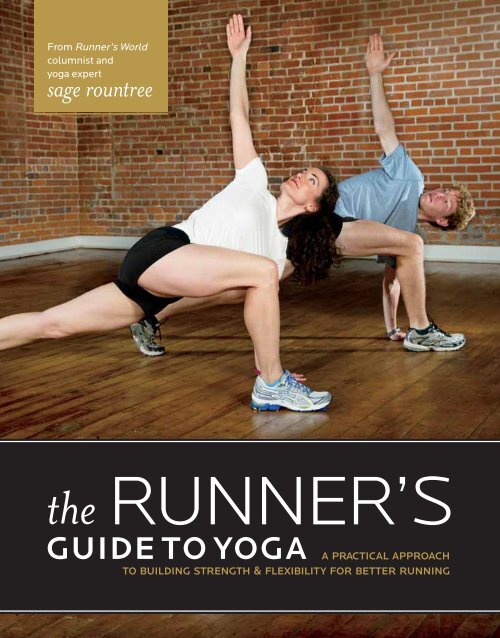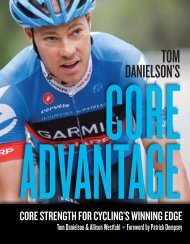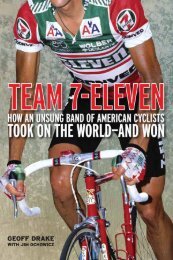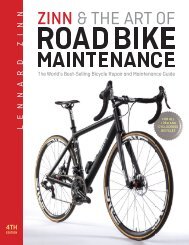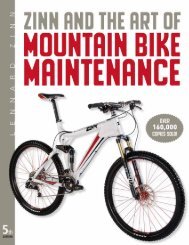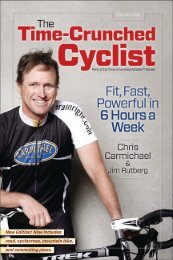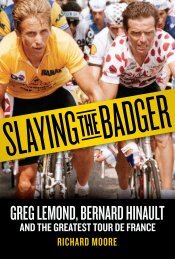a preview of The Runner's Guide to Yoga - VeloPress
a preview of The Runner's Guide to Yoga - VeloPress
a preview of The Runner's Guide to Yoga - VeloPress
You also want an ePaper? Increase the reach of your titles
YUMPU automatically turns print PDFs into web optimized ePapers that Google loves.
From Runner’s World<br />
columnist and<br />
yoga expert<br />
sage rountree<br />
the RUNNER’S<br />
GUIDE TO YOGA<br />
A PRACTICAL APPROACH<br />
TO BUILDING STRENGTH & FLEXIBILITY FOR BETTER RUNNING
PRAISE FOR SAGE ROUNTREE<br />
“Sage’s clear approach <strong>to</strong> incorporating yoga in<strong>to</strong> a training season perfectly addresses<br />
all the things athletes need <strong>to</strong> hear about flexibility and balanced conditioning—and<br />
Sage delivers it in a way that athletes can relate <strong>to</strong>.”<br />
—Karen Dubs, crea<strong>to</strong>r <strong>of</strong> the Flexible Warrior Athletic <strong>Yoga</strong> DVD series<br />
“<strong>Yoga</strong> is not only good for athletes—it is essential, for both the physical and mental<br />
benefits. … Sage shares the benefits that yoga has brought <strong>to</strong> her life as an athlete<br />
and <strong>of</strong>fers easy-<strong>to</strong>-follow yoga postures and breathing techniques <strong>to</strong> help athletes <strong>of</strong><br />
all sports get started with a safe and effective yoga routine and <strong>to</strong> help them avoid or<br />
rehabilitate an injury.”<br />
—Beryl Bender Birch, author <strong>of</strong> Power <strong>Yoga</strong> and Beyond Power <strong>Yoga</strong>,<br />
Direc<strong>to</strong>r/Founder <strong>of</strong> <strong>The</strong> Hard & <strong>The</strong> S<strong>of</strong>t <strong>Yoga</strong> Institute, and contribu<strong>to</strong>r <strong>to</strong> <strong>Yoga</strong> Journal<br />
PRAISE FOR THE ATHLETE’S GUIDE TO YOGA<br />
“Endurance athletes generally have poor flexibility, core strength, balance, and posture.<br />
Improving these can really change performance for the better. <strong>The</strong> Athlete’s <strong>Guide</strong> <strong>to</strong><br />
<strong>Yoga</strong> is a great resource <strong>to</strong> get you on the path <strong>to</strong> better training and racing.”<br />
—Joe Friel, founder <strong>of</strong> Ultrafit and author <strong>of</strong> <strong>The</strong> Triathlete’s Training Bible,<br />
<strong>The</strong> Cyclist’s Training Bible, and <strong>The</strong> Mountain Biker’s Training Bible<br />
“<strong>The</strong> Athlete’s <strong>Guide</strong> <strong>to</strong> <strong>Yoga</strong> is a practical in-your-body guidebook for anyone wanting<br />
<strong>to</strong> take their fitness routine in<strong>to</strong> new realms. Clearly written, beautifully illustrated,<br />
it’s a real resource for starting and deepening a practice that stays true <strong>to</strong> yoga’s depth.<br />
Postures, breathing, relaxation, meditation, training routines, it’s all here.”<br />
—Richard Faulds, Kripalu Center for <strong>Yoga</strong> & Health<br />
“Somehow Sage Rountree has managed <strong>to</strong> maintain her yogic voice … while also<br />
<strong>to</strong>ning it down just enough <strong>to</strong> speak directly <strong>to</strong> an athlete. … <strong>The</strong> book is straightforward<br />
without all the frou-frou and implied incense-burning and ohmmm <strong>of</strong> yoga that<br />
could turn <strong>of</strong>f some athletes. … Since she herself is a triathlete and runner, Rountree<br />
knows exactly where you get tight and why, what it feels like before and after certain<br />
workouts, the difficulties <strong>of</strong> combining a good yoga practice with hard training, and<br />
what’s realistic or not for an athlete.”<br />
—SNEWS®<br />
Sample pages from <strong>The</strong> <strong>Runner's</strong> <strong>Guide</strong> <strong>to</strong> <strong>Yoga</strong> by Sage Rountree<br />
Copyright 2012 <strong>VeloPress</strong> All rights reserved
“Whether you’re a yogini or you’ve never heard <strong>of</strong> downward-facing dog, you’ll come<br />
away with something useful from <strong>The</strong> Athlete’s <strong>Guide</strong> <strong>to</strong> <strong>Yoga</strong>.”<br />
—Women’s Adventure magazine<br />
“This comprehensive book on yoga for athletes makes a compelling case for why and,<br />
more importantly, how athletes <strong>of</strong> every stripe can benefit from making yoga a regular<br />
part <strong>of</strong> their workout regimens.”<br />
—American Council on Exercise Get Fit<br />
PRAISE FOR THE ATHLETE’S POCKET GUIDE TO YOGA<br />
“This sweet little book is a delightful and abundant source <strong>of</strong> yoga pose sequences.<br />
<strong>The</strong> Athlete’s Pocket <strong>Guide</strong> <strong>to</strong> <strong>Yoga</strong> is a great resource for yoga teachers and an easy<br />
source <strong>of</strong> inspiration and guidance for beginner <strong>to</strong> intermediate yogis.”<br />
—<strong>Yoga</strong>Basics.com<br />
“For time-crunched yogis and jocks who don’t even identify with the term yogi but<br />
want a good stretch or cross-training workout, take a look at <strong>The</strong> Athlete’s Pocket <strong>Guide</strong><br />
<strong>to</strong> <strong>Yoga</strong>. With no need <strong>to</strong> attend a class or even watch a DVD, there’s no excuse <strong>to</strong> not<br />
get a few poses in.”<br />
—GearJunkie.com<br />
Sample pages from <strong>The</strong> <strong>Runner's</strong> <strong>Guide</strong> <strong>to</strong> <strong>Yoga</strong> by Sage Rountree<br />
Copyright 2012 <strong>VeloPress</strong> All rights reserved
Copyright © 2012 by Sage Rountree<br />
All rights reserved. Printed in Canada.<br />
No part <strong>of</strong> this book may be reproduced, s<strong>to</strong>red in a retrieval system, or transmitted, in any form<br />
or by any means, electronic or pho<strong>to</strong>copy or otherwise, without the prior written permission <strong>of</strong> the<br />
publisher except in the case <strong>of</strong> brief quotations within critical articles and reviews.<br />
3002 Sterling Circle, Suite 100<br />
Boulder, Colorado 80301-2338 USA<br />
(303) 440-0601 · Fax (303) 444-6788 · E-mail velopress@competi<strong>to</strong>rgroup.com<br />
Distributed in the United States and Canada by Ingram Publisher Services<br />
Library <strong>of</strong> Congress<br />
Cataloging-in-Publication Data<br />
Rountree, Sage Hamil<strong>to</strong>n.<br />
<strong>The</strong> runner’s guide <strong>to</strong> yoga: a practical approach <strong>to</strong> building strength and flexibility<br />
for better running / Sage Rountree.<br />
p. cm.<br />
Includes bibliographical references and index.<br />
ISBN 978-1-934030-84-4 (pbk.: alk. paper)<br />
1. Hatha yoga. 2. Running—Training. I. Title.<br />
RC1220.Y64R687 2012<br />
613.7’046—dc23<br />
2012000698<br />
For information on purchasing <strong>VeloPress</strong> books,<br />
please call (800) 811-4210 ext. 2138 or visit www.velopress.com.<br />
Cover and interior design by Vicki Hopewell<br />
Cover and interior pho<strong>to</strong>graphs by Cindy Hamil<strong>to</strong>n<br />
Composition by Jane Raese<br />
Text set in Bembo.<br />
12 13 14 / 10 9 8 7 6 5 4 3 2 1<br />
Sample pages from <strong>The</strong> <strong>Runner's</strong> <strong>Guide</strong> <strong>to</strong> <strong>Yoga</strong> by Sage Rountree<br />
Copyright 2012 <strong>VeloPress</strong> All rights reserved
CONTENTS<br />
Preface xi<br />
Acknowledgments xiii<br />
Introduction xv<br />
PART I: OVERVIEW: HOW YOGA HELPS RUNNERS 1<br />
1 Strength and Flexibility 3<br />
2 Balance 9<br />
3 Focus 15<br />
PART II: POSES FOR STRENGTH AND FLEXIBILITY 21<br />
4 Hips and Thighs 23<br />
5 Core 51<br />
6 Lower Legs 73<br />
7 Upper Body 81<br />
PART III: FINDING THE RIGHT BALANCE 91<br />
8 Preventing and Correcting Overuse Injury 93<br />
9 Preventing Acute Injury 105<br />
10 Balancing Work and Rest 113<br />
11 Balancing Studio <strong>Yoga</strong> with Home Practice 117<br />
PART IV: EXERCISES FOR FOCUS 127<br />
12 <strong>Yoga</strong>’s Eight-Limbed Approach 129<br />
13 Breath Exercises 139<br />
14 Meditation Exercises 147<br />
Sample pages from <strong>The</strong> <strong>Runner's</strong> <strong>Guide</strong> <strong>to</strong> <strong>Yoga</strong> by Sage Rountree<br />
Copyright 2012 <strong>VeloPress</strong> All rights reserved<br />
ix
PART V: PUTTING IT TOGETHER 155<br />
15 Routines for Dynamic Warm-up Before a Run 157<br />
16 Routines for Practice During a Run 171<br />
17 Routines Following an Easy Run 175<br />
18 Routines Following a Hard Run or Race 185<br />
Recommended Resources 199<br />
Subject Index 205<br />
Poses Index 213<br />
About the Models 219<br />
About the Author 221<br />
x | CONTENTS<br />
Sample pages from <strong>The</strong> <strong>Runner's</strong> <strong>Guide</strong> <strong>to</strong> <strong>Yoga</strong> by Sage Rountree<br />
Copyright 2012 <strong>VeloPress</strong> All rights reserved
INTRODUCTION<br />
In this book, we will investigate how yoga will help your running. You’ll learn how<br />
yoga can prevent and correct running injuries, how yoga can make you feel (and yes,<br />
even look) better, and how yoga will give you new focus and tenacity with a direct<br />
positive effect on your running. We will explore which <strong>of</strong> the hundreds <strong>of</strong> yoga poses,<br />
exercises, and techniques <strong>to</strong> use, and I’ll explain why, how, and when <strong>to</strong> use them. In<br />
this book, then, you’ll find concrete advice on how <strong>to</strong> use yoga <strong>to</strong> be a better runner<br />
and a happier person.<br />
Instead <strong>of</strong> being a comprehensive catalog <strong>of</strong> every pose—for a more thorough<br />
look at the poses, please read my book <strong>The</strong> Athlete’s <strong>Guide</strong> <strong>to</strong> <strong>Yoga</strong>—this book covers<br />
poses <strong>of</strong> special use <strong>to</strong> runners, focusing on those that are safe for home practice.<br />
(Handstand, for example, can be a great teacher <strong>of</strong> proper alignment in both yoga and<br />
running, but it’s best learned in the presence <strong>of</strong> an experienced yoga educa<strong>to</strong>r.) Here,<br />
I’ll introduce yoga <strong>to</strong> those who are new <strong>to</strong> the practice and help those with some<br />
experience develop a home practice <strong>to</strong> complement their running.<br />
In Part I, we’ll look at how yoga helps runners by conferring strength, flexibility,<br />
balance, and focus in both physical and psychological ways. <strong>The</strong> second part <strong>of</strong> the<br />
book describes poses <strong>to</strong> use <strong>to</strong> improve running, targeting the main regions <strong>of</strong> the<br />
body we use in running: the hips and thighs; the core; the lower legs; and the upper<br />
body. In this section, we’ll talk about why and how <strong>to</strong> do these poses and how you<br />
can modify them <strong>to</strong> make them more or less intense. In Part III, we explore ways <strong>to</strong><br />
use yoga for balance. Being balanced in your body, in space, and in your approach <strong>to</strong><br />
work and rest is critical for injury prevention. We’ll move on <strong>to</strong> yoga philosophy in<br />
Sample pages from <strong>The</strong> <strong>Runner's</strong> <strong>Guide</strong> <strong>to</strong> <strong>Yoga</strong> by Sage Rountree<br />
Copyright 2012 <strong>VeloPress</strong> All rights reserved<br />
xv
Part IV, as we investigate the mental and spiritual aspects <strong>of</strong> the practice in ways that<br />
will hone your focus and sense <strong>of</strong> well-being. Finally, Part V details when <strong>to</strong> do these<br />
poses and exercises, outlining routines for practice before, after, and even during your<br />
runs and races.<br />
Using the techniques outlined in this book, you’ll learn more about yourself:<br />
where your perceived limits are and how <strong>to</strong> surpass them, when <strong>to</strong> push and when <strong>to</strong><br />
back <strong>of</strong>f, how <strong>to</strong> follow your breath and your intuition, and how <strong>to</strong> use competition<br />
<strong>to</strong> achieve peak performance.<br />
xvi | INTRODUCTION<br />
Sample pages from <strong>The</strong> <strong>Runner's</strong> <strong>Guide</strong> <strong>to</strong> <strong>Yoga</strong> by Sage Rountree<br />
Copyright 2012 <strong>VeloPress</strong> All rights reserved
Sample pages from <strong>The</strong> <strong>Runner's</strong> <strong>Guide</strong> <strong>to</strong> <strong>Yoga</strong> by Sage Rountree<br />
Copyright 2012 <strong>VeloPress</strong> All rights reserved<br />
PART I<br />
OVERVIEW:<br />
HOW YOGA<br />
helps<br />
RUNNERS
1<br />
STRENGTH AND FLEXIBILITY<br />
I HATED THE FIRST yoga class I attended. <strong>The</strong> problem wasn’t my flexibility;<br />
while some <strong>of</strong> the stretches were intense, I was familiar enough with stretching and<br />
didn’t have a problem twisting my body in<strong>to</strong> the shapes the teacher described. <strong>The</strong><br />
problem was that yoga was hard—much harder than I’d expected—in its demands on<br />
my strength. We were talked in<strong>to</strong> a pose and then held it for what felt like minutes<br />
on end while the teacher worked the room, <strong>of</strong>fering adjustments. Oh, no, I thought,<br />
he’s forgotten we’re all in this pose! I’ve been abandoned! My muscles are burning; my legs are<br />
shaking—how is this generating inner peace? I left with legs like jelly, feeling humbled and<br />
much, much weaker than I thought myself <strong>to</strong> be.<br />
Perhaps your experience will be the opposite. You may find the strength poses doable<br />
while the flexibility poses flummox you. Each <strong>of</strong> us has individual strengths and<br />
weaknesses. Often we have a deficiency in either strength or flexibility; sometimes we<br />
are lacking in both. <strong>The</strong> rare individual—including yoga practitioners—will maintain<br />
a healthy, dynamic balance between the two, exhibiting strength and flexibility in<br />
equal measure.<br />
What eventually brought me back <strong>to</strong> yoga was knowing that I needed balance<br />
in my body. I’d built strength in my marathon training, but I could feel my flexibility<br />
waning. By adding a 90-minute class once a week and revisiting a few poses at home<br />
after my runs, I brought my body back in<strong>to</strong> enough balance <strong>to</strong> finish my first marathon<br />
in just under four hours. In addition <strong>to</strong> the hip strength and leg flexibility that kept<br />
Sample pages from <strong>The</strong> <strong>Runner's</strong> <strong>Guide</strong> <strong>to</strong> <strong>Yoga</strong> by Sage Rountree<br />
Copyright 2012 <strong>VeloPress</strong> All rights reserved<br />
3
me on pace through the race, yoga helped me cultivate mental strength and a flexible<br />
attitude that enabled me <strong>to</strong> weather the highs and lows that come over the course <strong>of</strong><br />
26.2 miles. <strong>Yoga</strong> can help you find that same balance between strength and flexibility,<br />
whether your goal race is 100 meters or 100 miles.<br />
Sthira and Sukha<br />
<strong>The</strong> <strong>Yoga</strong> Sutras, a centuries-old series <strong>of</strong> aphorisms that define yoga, explain the<br />
method for quieting the fluctuations <strong>of</strong> the mind so that the practitioner can connect<br />
<strong>to</strong> his or her true nature (see Chapter 12 for an exploration <strong>of</strong> the sutras). Over the<br />
course <strong>of</strong> almost 200 verses, little reference is made <strong>to</strong> the physical practice—what<br />
most <strong>of</strong> us in the twenty-first-century West think <strong>of</strong> as yoga. <strong>The</strong> sutras’ take on the<br />
postures is Sthira sukham asanam. <strong>The</strong> Sanskrit translates, loosely, <strong>to</strong> this: <strong>The</strong> posture<br />
(asana) should be both firm (sthira) and easy (sukha).<br />
<strong>The</strong>se twin concepts, effort and ease, stability and mobility, strength and flexibility,<br />
must be present simultaneously. This concept applies not just <strong>to</strong> sitting in meditation<br />
(what the sutras are most likely prescribing) but <strong>to</strong> all physical activity, where we must<br />
balance a rigidity <strong>of</strong> form (in the skele<strong>to</strong>n, for example) with a fluidity <strong>of</strong> motion (in<br />
the muscles, for example). And it applies <strong>to</strong> running, <strong>to</strong>o, where we must balance stiffness<br />
<strong>of</strong> form with a fluid range <strong>of</strong> motion.<br />
STIFFNESS<br />
Think <strong>of</strong> elite runners. What words would you use <strong>to</strong> describe their form? Springy,<br />
snappy, floating. This comes from sthira, stiffness. Good runners are tight in the right<br />
places. Stiffness around the hips and core is critical for efficient transfer <strong>of</strong> energy <strong>to</strong><br />
the ground and for recoil that takes the energetic rebound from the ground and rolls<br />
it in<strong>to</strong> forward motion. A runner who is <strong>to</strong>o lax around the hips or weak around the<br />
core will sink in<strong>to</strong> the ground with each step. This is inefficient running, and it can<br />
lead <strong>to</strong> injury over time, as the joints are strained by excessive <strong>to</strong>rque.<br />
Through running, you will develop sport-specific strength. <strong>The</strong>re’s a reason that<br />
runners are obsessed with mileage: Generally speaking, running more miles confers efficiency,<br />
building strength in the hips and core muscles that supports a more economical<br />
stride. That means less effort at the same pace or greater ability <strong>to</strong> run faster paces.<br />
RANGE OF MOTION<br />
If you have had, at times, trouble reaching your shoelaces, then you know there is<br />
certainly such a thing as <strong>to</strong>o much stiffness. While you need strength <strong>to</strong> run well, you<br />
4 | STRENGTH AND FLEXIBILITY<br />
Sample pages from <strong>The</strong> <strong>Runner's</strong> <strong>Guide</strong> <strong>to</strong> <strong>Yoga</strong> by Sage Rountree<br />
Copyright 2012 <strong>VeloPress</strong> All rights reserved
also need enough flexibility and ease (sukha) <strong>to</strong> move fluidly through the proper range<br />
<strong>of</strong> motion and <strong>to</strong> access your strength. Too much stiffness in your hips can shorten<br />
your stride, thus limiting your speed, which is a fac<strong>to</strong>r <strong>of</strong> your stride rate and your<br />
stride length. Tightness in a specific muscle can alter your stride, as you subconsciously<br />
develop a little hiccup <strong>to</strong> work around it, and such gait modification can cause a host<br />
<strong>of</strong> problems up and down the kinetic chain <strong>of</strong> your body: knee trouble, foot issues,<br />
back pain.<br />
Developing appropriate flexibility in the muscles will allow you <strong>to</strong> find the most<br />
efficient patterns for your stride. Greater mobility in the joints <strong>of</strong> the feet, hips, and<br />
spine will ease strain in these areas and others, preventing injury and lending an overall<br />
sense <strong>of</strong> well-being.<br />
WORK AND REST<br />
We also see this balance between sthira and sukha in proper run training. Both hard<br />
workouts and easy recovery runs are necessary for the body <strong>to</strong> receive the proper dosage<br />
<strong>of</strong> stress and <strong>to</strong> take the time <strong>to</strong> adapt <strong>to</strong> the stress and grow stronger. <strong>The</strong> same<br />
holds true in your yoga practice. <strong>The</strong>re will be times <strong>to</strong> work and times <strong>to</strong> rest.<br />
I cover the balance between work and rest in more detail in Chapter 10, but for<br />
a much more detailed look at recovery and ways <strong>to</strong> support hard work with highquality<br />
rest, please refer <strong>to</strong> my book <strong>The</strong> Athlete’s <strong>Guide</strong> <strong>to</strong> Recovery.<br />
How <strong>Yoga</strong> Builds Strength<br />
As I discovered in my first yoga class, a physical yoga practice can quickly reveal the<br />
limitations <strong>of</strong> your strength. It can also work <strong>to</strong> build your strength, challenging your<br />
muscles in both isometric and iso<strong>to</strong>nic exercises.<br />
Isometric strength develops when you hold a pose for a long time, forcing your<br />
muscles <strong>to</strong> work against static resistance. This could mean pushing your feet in<strong>to</strong> the<br />
floor in a warrior pose or holding your hands <strong>to</strong> the ground in plank. Maintaining<br />
the position in a static hold and working against the steady resistance <strong>of</strong> the floor is<br />
key here. Such long holds develop the strength that helps you hold your core steady<br />
while you run.<br />
Iso<strong>to</strong>nic strength, however, comes from dynamic motion in and out <strong>of</strong> poses,<br />
as the muscles contract concentrically (while shortening) and eccentrically (while<br />
lengthening) as you move rhythmically. Your arm and leg muscles work in the same<br />
way as you run. Building iso<strong>to</strong>nic strength will support your running.<br />
<strong>Yoga</strong> poses use your body strength for resistance, but they are not a direct replacement<br />
for a strength-training program using weights. For some runners, yoga<br />
Sample pages from <strong>The</strong> <strong>Runner's</strong> <strong>Guide</strong> <strong>to</strong> <strong>Yoga</strong> by Sage Rountree<br />
Copyright 2012 <strong>VeloPress</strong> All rights reserved<br />
THE RUNNER’S GUIDE TO YOGA | 5
can suffice as a strength practice; for others, a gym-based routine is useful. If you are<br />
an efficient runner and powerful on hills, yoga may be a strength practice. If you are<br />
weak compared <strong>to</strong> others in your training and age group, combine yoga with a gymstrength<br />
routine.<br />
Many yoga classes feature a practice that moves forward and backward on the mat.<br />
Rectangular mats are set up with the short side forward, and the yogis move from<br />
front <strong>to</strong> back in sun salutations, standing poses, and even floor routines. For runners,<br />
this serves <strong>to</strong> build strength in the sagittal plane <strong>of</strong> forward motion—where we spend<br />
most <strong>of</strong> our time.<br />
<strong>Yoga</strong> can also help build strength side <strong>to</strong> side. More and more yoga styles are<br />
bringing students out <strong>of</strong> this linear plane—one runners are stuck in almost exclusively,<br />
as endurance sports emphasize forward motion—and in<strong>to</strong> sideways motion and<br />
spiraling twists. Look for rooms where the mats are laid out horizontally, or classes<br />
with “mandala” or “free flow” in the title. This approach is <strong>of</strong> great benefit <strong>to</strong> runners<br />
because it cultivates balance.<br />
How <strong>Yoga</strong> Increases Flexibility<br />
<strong>The</strong> flexibility you can gain through a physical yoga practice is extremely useful for<br />
your running. Proper stretching helps you balance the relationship between muscles in<br />
your body, loosening tight muscles that hamper a fluid, full range <strong>of</strong> motion.<br />
In yoga’s static stretches (poses held for a period <strong>of</strong> 30 seconds <strong>to</strong> two minutes or<br />
longer), you will stretch not only muscles but also, with longer holds, the fascia that<br />
surrounds and shoots through your muscles. This connective tissue can be elastic, but<br />
it can also stick <strong>to</strong> itself like a wad <strong>of</strong> plastic wrap. Proper stretching helps <strong>to</strong> smooth<br />
it back out.<br />
<strong>Yoga</strong> also moves dynamically, in sequences in which practitioners go from pose<br />
<strong>to</strong> pose with the breath. Dynamic movement aids flexibility in the muscles and emphasizes<br />
smooth, healthy range <strong>of</strong> motion at the joints. Lack <strong>of</strong> mobility at the joints<br />
can strain ligaments, tendons, and muscles and reduces efficiency. Hypermobility at<br />
the joints can cause problems, <strong>to</strong>o, but in most devoted runners, the trend is <strong>to</strong>ward<br />
stiffness rather than the excessive range <strong>of</strong> motion exhibited by dancers and gymnasts.<br />
Your goal will be <strong>to</strong> build enough flexibility <strong>to</strong> run with a full range <strong>of</strong> motion.<br />
Finding the Right Balance<br />
Most runners carry an imbalance <strong>of</strong> some sort: <strong>to</strong>p <strong>to</strong> bot<strong>to</strong>m, side <strong>to</strong> side, work <strong>to</strong><br />
rest. In Part III, we’ll look at self-tests you can use <strong>to</strong> determine where your own<br />
6 | STRENGTH AND FLEXIBILITY<br />
Sample pages from <strong>The</strong> <strong>Runner's</strong> <strong>Guide</strong> <strong>to</strong> <strong>Yoga</strong> by Sage Rountree<br />
Copyright 2012 <strong>VeloPress</strong> All rights reserved
imbalances lie. Many yoga poses naturally create balance by strengthening one part <strong>of</strong><br />
the body and stretching another. A lunge, for example, strengthens the front leg while<br />
stretching the back leg. At the same time, a lunge requires balance between the inner<br />
and outer thighs, the front and back <strong>of</strong> the <strong>to</strong>rso, and the upper and lower body. Some<br />
poses focus more on strength, others target flexibility, and still others balance strength<br />
and flexibility by focusing fully on rest.<br />
<strong>Yoga</strong> will help you balance strength and flexibility by increasing both and teaching<br />
you which types <strong>of</strong> exercises will best balance your needs. By cultivating balance,<br />
you’ll be able <strong>to</strong> run more mileage, faster, with less physical and mental effort. This<br />
balance is the focus <strong>of</strong> Chapter 2.<br />
Sample pages from <strong>The</strong> <strong>Runner's</strong> <strong>Guide</strong> <strong>to</strong> <strong>Yoga</strong> by Sage Rountree<br />
Copyright 2012 <strong>VeloPress</strong> All rights reserved<br />
THE RUNNER’S GUIDE TO YOGA | 7
4<br />
HIPS AND THIGHS<br />
YOUR HIPS AND LEGS are the drivetrain <strong>of</strong> your running stride. <strong>The</strong> stability<br />
<strong>of</strong> your hips and the mobility <strong>of</strong> your legs combine <strong>to</strong> move you over the ground. To<br />
that end, you need strength and flexibility in both the hips and the thighs <strong>to</strong> run well<br />
and avoid injury. <strong>Yoga</strong> <strong>of</strong>fers a host <strong>of</strong> exercises that build both.<br />
Standing Poses: Strength and Flexibility<br />
Nowhere in the catalog <strong>of</strong> yoga asanas do the twin qualities <strong>of</strong> sthira and sukha—<br />
stability and mobility, strength and flexibility—shine more than in the standing poses.<br />
Moving in and out <strong>of</strong> the poses requires and builds iso<strong>to</strong>nic strength, and holding<br />
them provides isometric exercise. When you flow from pose <strong>to</strong> pose, use the breath—<br />
generally, inhale <strong>to</strong> lift, exhale <strong>to</strong> lower. When you hold, allow the breath <strong>to</strong> come and<br />
go freely. Along the way, you gain flexibility and resilience through your legs.<br />
Sample pages from <strong>The</strong> <strong>Runner's</strong> <strong>Guide</strong> <strong>to</strong> <strong>Yoga</strong> by Sage Rountree<br />
Copyright 2012 <strong>VeloPress</strong> All rights reserved<br />
23
WARRIOR I<br />
WHY: Warrior I (Fig. 4.1) builds balanced strength in the muscles that act on the knee<br />
<strong>of</strong> the front leg while creating flexibility in the back-leg hip flexors and in the lower<br />
leg.<br />
HOW: Standing tall, step forward with your left leg and angle your right heel in<br />
slightly. Pointing your pelvis straight ahead, inhale and lift your arms. Exhaling, lunge<br />
your left knee <strong>to</strong>ward 90 degrees.<br />
VARIATIONS: <strong>The</strong> width and length between your feet can confer stability or challenge<br />
your balance. Change your stance until you find what’s right for you.<br />
If you feel stress in your back knee, lift the heel and roll <strong>to</strong> the ball <strong>of</strong> the back<br />
foot.<br />
Your arm position can change<br />
here: Arms can be parallel or hands<br />
can <strong>to</strong>uch; elbows can bend; hands<br />
can clasp behind your back.<br />
4.1 Warrior I<br />
24 | HIPS AND THIGHS<br />
Sample pages from <strong>The</strong> <strong>Runner's</strong> <strong>Guide</strong> <strong>to</strong> <strong>Yoga</strong> by Sage Rountree<br />
Copyright 2012 <strong>VeloPress</strong> All rights reserved
WARRIOR II<br />
WHY: Like warrior I, warrior II (Fig. 4.2) supports knee health; at the same time, it<br />
increases flexibility in the inner thighs.<br />
HOW: Take a wide stance, left <strong>to</strong>es turned out, right <strong>to</strong>es facing right. Inhale and lift<br />
your arms parallel <strong>to</strong> the floor; exhaling, lunge your left knee over your <strong>to</strong>es. Keep<br />
shoulders and pelvis stacked and squared <strong>to</strong> the long side <strong>of</strong> the mat, and turn just<br />
your head <strong>to</strong> look over your left hand.<br />
VARIATIONS: Tight hips can make a proper lunge difficult. If your left knee is moving<br />
<strong>to</strong> the right, shorten your stance.<br />
Add a side stretch <strong>to</strong> the pose by coming <strong>to</strong> exalted warrior (Fig. 4.3): Lift your<br />
front arm <strong>to</strong> the sky as you relax your back arm <strong>to</strong>ward the ground.<br />
4.2 Warrior II<br />
Sample pages from <strong>The</strong> <strong>Runner's</strong> <strong>Guide</strong> <strong>to</strong> <strong>Yoga</strong> by Sage Rountree<br />
Copyright 2012 <strong>VeloPress</strong> All rights reserved<br />
4.3 Exalted warrior<br />
THE RUNNER’S GUIDE TO YOGA | 25
WARRIOR III<br />
WHY: Warrior III (Fig. 4.4) builds strength in the glutes and other hip stabilizers while<br />
stretching the back <strong>of</strong> the standing leg. It requires stability through the core and a<br />
focused sense <strong>of</strong> balance.<br />
HOW: Stand tall and shift your weight on<strong>to</strong> your right leg. Hold shoulders, core, hips,<br />
and left leg in a long line as you hinge the pelvis forward and lift the left leg behind<br />
you.<br />
VARIATIONS: Coming in<strong>to</strong> and out <strong>of</strong> the pose with the breath makes a good dynamic<br />
warmup and workout for the hip muscles. Alternatively, holding the pose for a<br />
number <strong>of</strong> breaths is a good core challenge.<br />
To increase or decrease intensity, change the position <strong>of</strong> your arms. Hands can<br />
reach back in an inverted V, <strong>of</strong>f <strong>to</strong> the sides, or overhead for more work. Try holding<br />
hands in prayer position or interlacing your fingers behind your back <strong>to</strong> stretch your<br />
chest.<br />
4.4 Warrior III<br />
26 | HIPS AND THIGHS<br />
Sample pages from <strong>The</strong> <strong>Runner's</strong> <strong>Guide</strong> <strong>to</strong> <strong>Yoga</strong> by Sage Rountree<br />
Copyright 2012 <strong>VeloPress</strong> All rights reserved
TRIANGLE<br />
WHY: Triangle (Fig. 4.5) stretches the hamstrings and inner thigh on the front leg, the<br />
outer hip and calf on the back leg, and the <strong>to</strong>rso and chest.<br />
HOW: From a wide stance, turn your left <strong>to</strong>es out and angle your right foot roughly<br />
90 degrees relative <strong>to</strong> the left. Keeping your spine long, extend it over your left leg as<br />
you rest your left hand on your thigh, shin, or ankle. Reach your right arm upward.<br />
VARIATIONS: Use a block on either side <strong>of</strong> your left leg <strong>to</strong> rest your hand or go<br />
hands-free for a strength challenge.<br />
Experiment <strong>to</strong> determine the best position for your hips. Rolling your right hip<br />
forward and pulling your left hip <strong>to</strong> the right slightly may allow your hip <strong>to</strong> stretch<br />
more.<br />
Choose a position for your neck and head that works for you. You can look down,<br />
forward, or up.<br />
4.5 Triangle<br />
Sample pages from <strong>The</strong> <strong>Runner's</strong> <strong>Guide</strong> <strong>to</strong> <strong>Yoga</strong> by Sage Rountree<br />
Copyright 2012 <strong>VeloPress</strong> All rights reserved<br />
THE RUNNER’S GUIDE TO YOGA | 27
SIDE ANGLE<br />
WHY: Like warrior II, side angle (Fig. 4.6) <strong>of</strong>fers an inner-thigh stretch while building<br />
strength isometrically. It also stretches the entire side <strong>of</strong> the body and the chest.<br />
HOW: From triangle pose, bend your left knee and rest your left elbow on your left<br />
thigh. Take your right arm by your head, creating a diagonal line from the right heel<br />
through the right hand.<br />
VARIATIONS: For a deeper stretch, take your left hand <strong>to</strong> a block or <strong>to</strong> the floor, either<br />
inside or outside your left foot.<br />
To stretch the chest more, lay your right forearm on your lower back, tucking the<br />
right fingers between the waist and left thigh.<br />
4.6 Side angle<br />
28 | HIPS AND THIGHS<br />
Sample pages from <strong>The</strong> <strong>Runner's</strong> <strong>Guide</strong> <strong>to</strong> <strong>Yoga</strong> by Sage Rountree<br />
Copyright 2012 <strong>VeloPress</strong> All rights reserved
PYRAMID<br />
WHY: Pyramid pose provides a deep hamstring and hip stretch for the front leg, a calf<br />
stretch for the back leg, and either a core challenge or a release for the back, depending<br />
on whether you hold your back actively (Fig. 4.7) or passively (Fig. 4.8).<br />
HOW: From mountain pose, take a moderate step forward with your left leg. Angle<br />
your right heel in slightly. Keeping hips facing forward, fold your pelvis until you feel<br />
a hamstring stretch.<br />
VARIATIONS: To work your core, hold your spine parallel <strong>to</strong> the floor. For more <strong>of</strong> a<br />
stretch, let your back arc over your front leg.<br />
For challenge in the core work, take your arms <strong>to</strong> the sides or overhead. For<br />
release in the stretch, hands can rest on the front thigh, the shin, blocks, or the floor.<br />
4.7 Pyramid with active back 4.8 Pyramid with passive back<br />
Sample pages from <strong>The</strong> <strong>Runner's</strong> <strong>Guide</strong> <strong>to</strong> <strong>Yoga</strong> by Sage Rountree<br />
Copyright 2012 <strong>VeloPress</strong> All rights reserved<br />
THE RUNNER’S GUIDE TO YOGA | 29
Sample pages from <strong>The</strong> <strong>Runner's</strong> <strong>Guide</strong> <strong>to</strong> <strong>Yoga</strong> by Sage Rountree<br />
Copyright 2012 <strong>VeloPress</strong> All rights reserved<br />
PART V<br />
PUTTING<br />
it<br />
TOGETHER
15<br />
ROUTINES FOR DYNAMIC WARM-UP<br />
BEFORE A RUN<br />
THE STATIC STRETCHING provided by holding a yoga pose is useful, but it<br />
should not be done just before a workout. Recent studies have shown that such static<br />
stretching can diminish short-term strength in the muscles. Instead <strong>of</strong> following the<br />
old-school model <strong>of</strong> running a few laps <strong>of</strong> the track, then flinging a leg up on the<br />
fence as you fold over <strong>to</strong> stretch your hamstrings, use a dynamic warm-up. <strong>Yoga</strong> is<br />
perfect for this.<br />
In a dynamic warm-up routine, you’ll move in and out <strong>of</strong> poses without lingering<br />
in them. <strong>The</strong> goal is <strong>to</strong> move through your range <strong>of</strong> motion, priming the muscles<br />
for the work you will soon do. <strong>The</strong> dynamic warm-up helps get the appropriate<br />
muscles firing. For example, paying special attention <strong>to</strong> warming up your hip muscles,<br />
especially the glutes, ensures you are beginning your run with appropriate muscular<br />
engagement, which can help prevent injury down the line by keeping the workload<br />
in the right muscles.<br />
Before you begin any <strong>of</strong> these routines, stand in mountain pose for a few breaths.<br />
Set an intention for your training session, so that you enter it with a clear sense <strong>of</strong><br />
purpose. You can use this time <strong>to</strong> commit <strong>to</strong> a mantra, set parameters for your interval<br />
pacing, or simply appreciate the blessing <strong>of</strong> being strong enough <strong>to</strong> run <strong>to</strong>day. Move<br />
through the dynamic warm-up with a focus on your breath. This helps set the <strong>to</strong>ne<br />
for a fantastic run.<br />
Sample pages from <strong>The</strong> <strong>Runner's</strong> <strong>Guide</strong> <strong>to</strong> <strong>Yoga</strong> by Sage Rountree<br />
Copyright 2012 <strong>VeloPress</strong> All rights reserved<br />
157
SUN SALUTATIONS WITH LUNGES<br />
WHY: Sun salutations engage your whole body, and they use your mind and breath<br />
<strong>to</strong> synchronize your motion <strong>to</strong> your inhalations and exhalations. As such, they make a<br />
fantastic pre-run warm-up.<br />
Standing in mountain pose, inhale and lift your arms<br />
overhead.<br />
exhaling, lower your body halfway<br />
<strong>to</strong> the ground, elbows in tight.<br />
Inhaling, swing hips forward and<br />
open your chest for upward-<br />
facing dog;<br />
158 | ROUTINES FOR DYNAMIC WARM-UP BEFORE A RUN<br />
Sample pages from <strong>The</strong> <strong>Runner's</strong> <strong>Guide</strong> <strong>to</strong> <strong>Yoga</strong> by Sage Rountree<br />
Copyright 2012 <strong>VeloPress</strong> All rights reserved<br />
Exhaling, dive forward<br />
from the hips<br />
and come in<strong>to</strong> a<br />
forward fold. >>><br />
exhaling, come <strong>to</strong> downward-<br />
facing dog. >>>
Inhaling, lift your back<br />
until it is parallel with<br />
the ground;<br />
Inhaling, step right foot forward;<br />
exhaling, lower both hips <strong>to</strong> lunge.<br />
exhaling, fold again. Inhaling, step your right foot back <strong>to</strong><br />
a lunge; exhaling, lower your hips in<br />
the lunge.<br />
Inhaling, step your<br />
left foot forward and<br />
lengthen your back;<br />
Sample pages from <strong>The</strong> <strong>Runner's</strong> <strong>Guide</strong> <strong>to</strong> <strong>Yoga</strong> by Sage Rountree<br />
Copyright 2012 <strong>VeloPress</strong> All rights reserved<br />
exhaling, fold<br />
forward.<br />
Inhaling, step left foot back <strong>to</strong> plank,<br />
Inhaling, sweep<br />
your arms<br />
overhead as you<br />
rise <strong>to</strong> standing;<br />
exhaling, lower your<br />
hands <strong>to</strong> prayer position.<br />
Repeat with the left foot<br />
leading; aim for four,<br />
six, or eight rounds.<br />
THE RUNNER’S GUIDE TO YOGA | 159
Abdominal muscles, 51, 81, 97, 140<br />
Ability, testing, 115<br />
Aerobic base, building, 113<br />
Ahimsa, 130<br />
Alignment, 16, 117, 120<br />
Allergies, 141<br />
Anusara<br />
described, 120<br />
using, 118 (table)<br />
Aparigraha, 130<br />
Asana, 4, 23, 67, 119<br />
described, 133–134<br />
Ashtanga<br />
described, 120<br />
Primary Series <strong>of</strong>, 120<br />
using, 118 (table)<br />
Asteya, 130<br />
Asthma, 141<br />
Athlete’s <strong>Guide</strong> <strong>to</strong> Recovery, <strong>The</strong> (Rountree),<br />
5, 116<br />
Athlete’s <strong>Guide</strong> <strong>to</strong> <strong>Yoga</strong>: A Personalized<br />
Practice (Rountree), 125<br />
Awareness, 15, 135, 140<br />
breath, 19, 134, 139, 151<br />
mind-body, 9, 11, 126<br />
Sample pages from <strong>The</strong> <strong>Runner's</strong> <strong>Guide</strong> <strong>to</strong> <strong>Yoga</strong> by Sage Rountree<br />
Copyright 2012 <strong>VeloPress</strong> All rights reserved<br />
SUBJECT INDEX<br />
Back, strong, 61, 81, 120<br />
Back extension, 61, 97<br />
Backbends, 10, 13, 36, 115<br />
active/passive, 84<br />
Balance, 3, 4, 5, 17, 81, 93, 141, 171<br />
arm, 110, 136<br />
body/space, 10–11<br />
building, 6, 7, 10, 19<br />
core and, 97<br />
finding, 6–7, 110<br />
front-<strong>to</strong>-back, 94, 97<br />
injuries and, 105<br />
left-<strong>to</strong>-right, 100<br />
maintaining, 9, 10<br />
mind, 11<br />
shoes and, 174<br />
spirit, 11<br />
<strong>to</strong>p-<strong>to</strong>-bot<strong>to</strong>m, 102<br />
work-rest, 11<br />
Baptiste Power <strong>Yoga</strong>, 119<br />
Barkan<br />
described, 121<br />
using, 118 (table)<br />
Barkan, Jimmy, 121<br />
Base period, 113, 114, 119, 120, 121, 122<br />
205
Bhagavad Gita, 129<br />
Bikram<br />
described, 121<br />
using, 118 (table)<br />
Body<br />
listening <strong>to</strong>, 135<br />
mind and, 9<br />
Brahmacharya, 130, 131<br />
Breath, 135, 136<br />
awareness <strong>of</strong>, 19, 134, 139, 151<br />
counting, 141, 151, 152<br />
exercises, 15, 18, 115, 129, 140–141<br />
footfalls and, 142, 152<br />
imposition <strong>of</strong>, 141<br />
pace and, 140, 142<br />
restrictions on, 141<br />
running and, 140, 145<br />
in space, 140<br />
techniques, 142–144<br />
in time, 140–142<br />
warrior’s, 142<br />
yoga and, 140–141<br />
Breathing, 9, 15, 52, 105, 139<br />
adjusting, 17<br />
alternate-nostril, 145<br />
conscious, 172–173<br />
correct, 134<br />
focus on, 81<br />
form and, 16, 17<br />
inhibiting, 17<br />
perceived, 141<br />
rhythmic, 17<br />
<strong>to</strong>xins and, 18<br />
Build period, 121, 122<br />
Burnout, 10<br />
Calisthenics, 133<br />
Center <strong>of</strong> gravity, 11<br />
Centeredness, 148<br />
Cheating, 131<br />
Chest muscles, 97<br />
Chest openness, 120<br />
206 | SUBJECT INDEX<br />
Sample pages from <strong>The</strong> <strong>Runner's</strong> <strong>Guide</strong> <strong>to</strong> <strong>Yoga</strong> by Sage Rountree<br />
Copyright 2012 <strong>VeloPress</strong> All rights reserved<br />
Choudhury, Bikram, 121<br />
Cleanliness, 126, 131<br />
Confidence, gaining, 131<br />
Connections, 11, 135<br />
Consciousness, 147<br />
Consistency, importance <strong>of</strong>, 113<br />
Contentment, 31, 132<br />
Cooling down, 185<br />
Core<br />
balance and, 97<br />
breath for, 142<br />
building, 4, 58, 122<br />
maintaining, 12, 122<br />
stable, 51–52<br />
Core exercises, back-extension, 84<br />
Core fusion yoga<br />
described, 122<br />
using, 118 (table)<br />
Core yoga, using, 118 (table)<br />
Counting meditation, described, 151<br />
Coveting, 131<br />
Csíkszentmihályi, Mihály, 136<br />
Deconditioning, 73<br />
Desikachar, T. K. V., 129<br />
Devi, Nischala Joy, 129<br />
Dharana, 135–136, 151<br />
Dharma talk, 153<br />
Diaphragm, 51, 142<br />
Diyana, 151<br />
described, 136–137<br />
Drishti, 136<br />
Dynamic movement, 6, 10<br />
Efficiency, 4, 16, 17, 73, 131, 174<br />
breathing and, 139<br />
maintaining, 134<br />
Elbows, building, 110<br />
Emotions, 147, 152<br />
Endurance, 100, 131, 148<br />
breathing and, 139<br />
keys <strong>to</strong>, 16–18
Energy, 19, 131, 133<br />
breathing and, 139<br />
conserving, 17<br />
freeing up, 132<br />
universal, 137<br />
Envy, 130, 131<br />
Equanimity, developing, 132<br />
Erec<strong>to</strong>r spinae muscles, 51<br />
Exercise, 135<br />
meditative, 151–152<br />
Exhalation, 18, 23, 81, 140, 141, 142, 151,<br />
152<br />
Firmness, s<strong>of</strong>tness and, 52<br />
Fitness, 18, 113<br />
Flexibility, 36, 61, 123, 171<br />
building, 5, 6, 23, 31, 175<br />
hip, 12, 133<br />
leg, 3<br />
stability and, 100<br />
stiffness and, 9<br />
strength and, 4, 7, 23, 93, 100, 129<br />
Flow yoga, 117, 122, 137<br />
breath for, 142<br />
described, 119<br />
using, 118 (table)<br />
Fluidity, stiffness and, 4<br />
Focus, 16, 18, 81, 114, 117, 134, 136, 142,<br />
147, 171<br />
breathing and, 139<br />
building, 133, 175<br />
running and, 15<br />
<strong>to</strong>ols for, 151<br />
Footfalls, 17<br />
breath and, 142, 152<br />
Form<br />
breathing and, 16, 17<br />
efficient, 16, 17<br />
Forrest, Ana, 119<br />
Forrest <strong>Yoga</strong>, 119<br />
Forward motion, emphasizing, 6<br />
Free flow, 6<br />
Sample pages from <strong>The</strong> <strong>Runner's</strong> <strong>Guide</strong> <strong>to</strong> <strong>Yoga</strong> by Sage Rountree<br />
Copyright 2012 <strong>VeloPress</strong> All rights reserved<br />
Gannon, Sharon, 119<br />
Goals, 19, 61, 131, 132, 137, 147<br />
race, 133<br />
training, 123, 124<br />
workouts and, 18<br />
Gym-strength routines, 6<br />
Gymnastics, 133<br />
Hamstrings, 10, 94, 97, 124<br />
stretching, 93, 113, 157<br />
Happiness, 131, 132<br />
Hatha, 120<br />
described, 119<br />
using, 118 (table)<br />
Heart <strong>of</strong> <strong>Yoga</strong>, <strong>The</strong> (Desikachar), 129<br />
Hip flexors, 10, 94, 95<br />
building, 58<br />
suppleness <strong>of</strong>, 93<br />
Hips, 52, 148<br />
building, 4, 102<br />
stability <strong>of</strong>, 23<br />
Home practice, 124–126, 142<br />
Honesty, practicing, 130<br />
Hot yoga, 123<br />
using, 118 (table)<br />
Hurdler’s stretch, 171<br />
Hypermobility, 6<br />
Iliotibial (IT) band, 9, 51<br />
Imbalance, 93, 100<br />
injuries and, 9, 10, 105<br />
Incontinence, 71<br />
Inhalation, 23, 81, 140–141, 142, 151, 152<br />
Injuries, 117, 124<br />
balance and, 105<br />
imbalance and, 9, 10, 105<br />
inefficient running and, 4<br />
mental, 10<br />
overuse, 9, 93, 105, 130<br />
preventing, 5, 52, 122, 157<br />
training and, 130<br />
Intensity, 114, 115, 135, 188, 194<br />
SUBJECT INDEX | 207
Interconnectedness, 137<br />
Intercostal muscles, 142<br />
Internal dialogue, 131<br />
Internal experience, focus on, 134<br />
Ishvara pranidhana, 131, 133<br />
Isometric exercises, 5, 23<br />
Iso<strong>to</strong>nic exercises, 5, 23<br />
Iyengar<br />
described, 120<br />
using, 118 (table)<br />
Iyengar, B. K. S., 120, 129<br />
Jealousy, 130<br />
Jivamukti <strong>Yoga</strong>, 119<br />
Jois, K. Pattabhi, 120<br />
Karma yoga, 129<br />
Kinetic chain, 97, 100<br />
Knee trouble, 5<br />
Kripalu<br />
described, 121<br />
using, 118 (table)<br />
Kripalu Center for <strong>Yoga</strong> and Health, 121,<br />
153<br />
Lateral movement, 100<br />
Leary, Timothy, 135<br />
Life, David, 119<br />
Light on <strong>Yoga</strong> (Iyengar), 120<br />
Locks, 51, 71, 120<br />
Lovingkindness, 152<br />
Lower body, upper body and, 81<br />
Lower leg<br />
running stride and, 73<br />
strengthening, 174<br />
Mala, 152<br />
Mandala, 6<br />
Mantras, 133, 136, 151, 152, 15<br />
Meditation, 113, 129, 132–133, 147, 153<br />
counting, 151<br />
incorporating, 152<br />
mantra, 151<br />
208 | SUBJECT INDEX<br />
Sample pages from <strong>The</strong> <strong>Runner's</strong> <strong>Guide</strong> <strong>to</strong> <strong>Yoga</strong> by Sage Rountree<br />
Copyright 2012 <strong>VeloPress</strong> All rights reserved<br />
mental/spiritual side <strong>of</strong>, 148<br />
moving, 151–152<br />
sitting and, 151–152<br />
Mental skills, 13, 113, 171<br />
Metta, 152<br />
Mind-body awareness, 9, 11, 126<br />
Mind-body-breath component, 122<br />
Mindfulness, practicing, 115<br />
Mobility, 4, 6, 23, 67<br />
stability and, 52<br />
Mood, 115<br />
Motion, fluidity <strong>of</strong>, 4<br />
Mula bandha, 51<br />
Muscular engagement, 115, 157<br />
Mysore, described, 120<br />
Negative behaviors, avoiding, 130–131<br />
Neural connections, 10<br />
Niebuhr, Reinhold, 115<br />
Niyama, described, 131–133<br />
Numbers, repetition <strong>of</strong>, 151<br />
Obliques, 142<br />
external/internal, 51<br />
Off-season period, 114, 120, 123<br />
1–2 (or 1/2), described, 119<br />
1–3, described, 119<br />
Openness, strength and, 81<br />
Overreaching, 130<br />
Overstretching, 97, 123<br />
Overthinking, 137<br />
Pace, 16, 131, 141<br />
breath and, 140, 142<br />
recovery, 145<br />
Pain<br />
avoiding, 73<br />
back, 5, 94<br />
Parasympathetic nervous system, 141, 194<br />
Pelvic floor, maintaining, 71<br />
Pelvis, 10, 16, 17, 51, 94, 97<br />
spine and, 52<br />
stable, 81
Performance, 130, 136<br />
Periodization, principles <strong>of</strong>, 122<br />
Perspective, conferring, 18–19<br />
Pilates<br />
described, 122<br />
using, 118 (table)<br />
Poses, 3, 4, 61, 117, 134, 135, 139<br />
arm-balancing, 136<br />
balance, 105, 124, 133, 142<br />
challenging, 16, 124<br />
dynamic, 52<br />
easy, 13<br />
holding, 157<br />
kneeling, 76<br />
relaxing, 121<br />
res<strong>to</strong>rative, 18<br />
squatting, 73<br />
standing, 6<br />
static, 52<br />
strength, 23, 194<br />
Post-run routine, challenging/relaxing,<br />
175<br />
Power yoga<br />
described, 119<br />
using, 118 (table)<br />
Prana Flow <strong>Yoga</strong>, 119<br />
Pranayama, described, 134<br />
Pratyahara, described, 134–135<br />
Precious jewels, 152<br />
Props, using, 124, 125<br />
Psoas, 51, 52<br />
Psychological <strong>to</strong>ols, work/rest balance<br />
and, 114–116<br />
Quadratus lumborum, 51<br />
Quadriceps, 93, 94<br />
Range <strong>of</strong> motion, 4–5, 6, 88, 157<br />
Rea, Shiva, 119<br />
Recovery, 5, 12, 121, 145, 188, 194<br />
importance <strong>of</strong>, 116<br />
Rectus abdominis, 51<br />
Relaxation, 17, 18, 131, 134, 188, 194<br />
Sample pages from <strong>The</strong> <strong>Runner's</strong> <strong>Guide</strong> <strong>to</strong> <strong>Yoga</strong> by Sage Rountree<br />
Copyright 2012 <strong>VeloPress</strong> All rights reserved<br />
Resilience, 23, 51<br />
Rest, 124, 194<br />
importance <strong>of</strong>, 116<br />
recovery and, 12<br />
work and, 5, 11, 93, 113, 114<br />
Res<strong>to</strong>rative yoga, 114, 116, 194–195<br />
described, 121<br />
using, 118 (table)<br />
Roach, Geshe Michael, 129<br />
Rota<strong>to</strong>r cuffs, strain on, 124<br />
Running, 16–17<br />
breath and, 145<br />
focus and, 15<br />
inefficient, 4<br />
medium-intensity, 12<br />
yoga and, 12, 15, 142, 171<br />
Sagittal plane, 100<br />
Samadhi, described, 137<br />
San<strong>to</strong>sha, 131, 132<br />
Satchidananda, Swami, 129<br />
Satya, 130<br />
Saucha, 126, 131, 132<br />
Season, yoga practice and, 11–12, 132<br />
Self-control, 131<br />
Self-criticism, 19<br />
Self-improvement, 18<br />
Self-knowledge, 18, 133<br />
Self-study, 131<br />
Shambhala Mountain Center, 153<br />
Shanti, 151<br />
Shin splints, 76<br />
Shoes, 73<br />
balance and, 174<br />
motion-control, 102<br />
stabilizing, 123<br />
Shoulders, building, 110<br />
Side bends, 10<br />
Sitting<br />
comfortable way for, 148–150<br />
meditation and, 151–152<br />
Snapping back, 15–16<br />
S<strong>of</strong>tness, firmness and, 52<br />
SUBJECT INDEX | 209
Space, 136<br />
breath in, 140<br />
Spine, 51, 148<br />
long, 81<br />
pelvis and, 52<br />
strong, 133<br />
Split stance, 31<br />
Squatting, kneeling and, 79<br />
Stability, 4, 23, 67, 102, 123<br />
flexibility and, 100<br />
mobility and, 52<br />
Sthira, 4, 23, 52<br />
sukha and, 5, 93, 129<br />
Stiffness, 5<br />
flexibility and, 9<br />
fluidity and, 4<br />
Strength, 51, 122, 131, 133, 171<br />
back, 98<br />
building, 4, 5–6, 19, 31, 52, 58, 61, 120,<br />
131, 175<br />
flexibility and, 4, 7, 23, 93, 100, 129<br />
hip, 3<br />
maintaining, 119, 121<br />
mental, 4<br />
openness and, 81<br />
tapping in<strong>to</strong>, 114–115<br />
Strength training, 5<br />
Stress, 114, 116<br />
adapting <strong>to</strong>, 5<br />
training, 123<br />
Stretches, 3, 7, 73, 84, 121, 123<br />
asymmetrical, 188<br />
deep, 185<br />
finish-line, 185<br />
hamstring, 96<br />
hip, 175<br />
hurdler’s, 171<br />
intensity <strong>of</strong>, 36<br />
inverted, 188<br />
light, 188, 194<br />
lower back, 94<br />
proper, 6<br />
static, 157<br />
210 | SUBJECT INDEX<br />
Sample pages from <strong>The</strong> <strong>Runner's</strong> <strong>Guide</strong> <strong>to</strong> <strong>Yoga</strong> by Sage Rountree<br />
Copyright 2012 <strong>VeloPress</strong> All rights reserved<br />
strap, 82, 96<br />
symmetrical, 188<br />
Stride, 4, 5<br />
running, 23, 31, 73, 76, 88<br />
Sukha, 4, 23, 52<br />
sthira and, 5, 93, 129<br />
Sutras, 4, 129, 130<br />
Svadyaya, 131, 133<br />
Sympathetic nervous system, 141<br />
Tapas, 131, 132–133<br />
Tension, releasing, 17, 18, 140<br />
Thighs, 94<br />
strengthening, 102<br />
Tibialis muscles, 76<br />
Tightness, 5, 94, 97, 122<br />
Time, 136<br />
breath in, 140–142<br />
Toxins, breathing and, 18<br />
Training, 3, 124, 129<br />
breaks from, 114<br />
complementing, 117<br />
cycles, 11, 119, 120, 122, 123, 175<br />
focusing on, 114<br />
injuries and, 130<br />
plan, 122, 129, 132<br />
sessions, 152, 157<br />
undermining, 118<br />
Transversus abdominis, 16, 51, 142<br />
Tuning in/tuning out, 135<br />
2–3 (or 2/3), described, 119<br />
Ujjayi, 145<br />
described, 142<br />
Upper body<br />
lower body and, 81<br />
running stride and, 88<br />
Variety, importance <strong>of</strong>, 113<br />
Video classes, 125, 126<br />
Vinyasa, 120, 122<br />
described, 119<br />
using, 118 (table)
Warm-ups, 134, 157, 175<br />
quick-fix, 168<br />
sequences <strong>of</strong>, 158–167<br />
Warm yoga, 123<br />
Weaknesses, 100, 122<br />
Work/rest balance, 5, 11, 93<br />
psychological <strong>to</strong>ols for, 114–116<br />
yoga and, 113–114<br />
Workouts, 13, 132, 135<br />
goals and, 18<br />
intensity <strong>of</strong>, 122<br />
planning, 126<br />
recovery and, 121<br />
yoga and, 185<br />
Wrists, building, 110<br />
Yamas, described, 130<br />
<strong>Yoga</strong><br />
achieving, 130<br />
as action, 129<br />
defined, 4, 9, 129, 147<br />
res<strong>to</strong>rative, 114, 116, 118 (table), 121,<br />
194–195<br />
Sample pages from <strong>The</strong> <strong>Runner's</strong> <strong>Guide</strong> <strong>to</strong> <strong>Yoga</strong> by Sage Rountree<br />
Copyright 2012 <strong>VeloPress</strong> All rights reserved<br />
running and, 12, 15, 142, 171<br />
styles <strong>of</strong>, 118, 118 (table), 123<br />
workouts and, 185<br />
<strong>Yoga</strong> classes, 123–124, 126<br />
choosing, 118–122<br />
“<strong>Yoga</strong> for Athletes” classes, 126<br />
<strong>Yoga</strong> practice, 115, 123, 132, 135<br />
adjusting, 12, 19<br />
medium-intensity, 12, 116<br />
rigorous, 114, 122, 175<br />
space for, 125–126<br />
time for, 126<br />
<strong>Yoga</strong> studios, 118, 125, 153<br />
home practice and, 126<br />
<strong>Yoga</strong> Sutras, 4, 129, 133, 147<br />
<strong>Yoga</strong> teachers, 124<br />
looking for, 122–123<br />
<strong>Yoga</strong>lates<br />
described, 122<br />
using, 118 (table)<br />
<strong>Yoga</strong>Vibes, 125<br />
SUBJECT INDEX | 211
ABOUT THE MODELS<br />
THOMAS GRAHAM is a senior at Cary Academy in Cary, North Carolina. For the<br />
past five years he has trained and competed in cross-country and distance track races<br />
around the country. Since starting competitive distance running, Thomas has trained<br />
without any major injuries and largely attributes that <strong>to</strong> the implementation <strong>of</strong> yoga<br />
and similar strength and flexibility training as part <strong>of</strong> his regimen. As a freshman, he<br />
was third nationally in the USATF Age Group Cross-Country Championships. As a<br />
senior, he finished ninth in the United States in the 2011 Footlocker Cross Country<br />
Championships in San Diego. He has run 14:45 for 5K and 9:00 for 2 miles. He will<br />
attend Stanford University and compete on both the cross-country and track teams.<br />
KRISTIN WATSON was a 400-meter hurdler at West Virginia University from 1998 <strong>to</strong><br />
2002 and a member <strong>of</strong> the distance medley team that won the 2000 Penn Relays. In<br />
college she met her future husband, Peter, also a member <strong>of</strong> the WVU track and field<br />
team, member <strong>of</strong> the Canadian National Track and Field Team, and current men’s<br />
cross-country coach at the University <strong>of</strong> Virginia. This relationship sent her on the<br />
journey <strong>to</strong> become a distance runner, and she has completed several half-marathons<br />
around the country. In addition <strong>to</strong> her work as an elementary school art teacher, she<br />
teaches group exercise and finds great satisfaction in the diversity and combination <strong>of</strong><br />
group fitness, the practice <strong>of</strong> yoga, and daily runs.<br />
Sample pages from <strong>The</strong> <strong>Runner's</strong> <strong>Guide</strong> <strong>to</strong> <strong>Yoga</strong> by Sage Rountree<br />
Copyright 2012 <strong>VeloPress</strong> All rights reserved<br />
219
ABOUT THE AUTHOR<br />
SAGE ROUNTREE is an internationally recognized authority in yoga for athletes and<br />
an endurance sports coach with certifications from USA Triathlon and RRCA; she<br />
also holds a PhD in English literature. She is the author <strong>of</strong> <strong>The</strong> Athlete’s <strong>Guide</strong> <strong>to</strong> <strong>Yoga</strong><br />
(2008), <strong>The</strong> Athlete’s Pocket <strong>Guide</strong> <strong>to</strong> <strong>Yoga</strong> (2009), and <strong>The</strong> Athlete’s <strong>Guide</strong> <strong>to</strong> Recovery<br />
(2011); crea<strong>to</strong>r <strong>of</strong> <strong>The</strong> Athlete’s <strong>Guide</strong> <strong>to</strong> <strong>Yoga</strong> DVD (Endurance Films, 2008); and a<br />
regular contribu<strong>to</strong>r <strong>to</strong> Runner’s World, <strong>Yoga</strong> Journal, and USA Triathlon Life.<br />
An Experienced Registered <strong>Yoga</strong> Teacher with the <strong>Yoga</strong> Alliance, Sage is on the<br />
faculty at the Kripalu Center for <strong>Yoga</strong> and Health and teaches at <strong>Yoga</strong>Vibes.com. Her<br />
students include casual athletes, dedicated age-groupers, Olympians, and many University<br />
<strong>of</strong> North Carolina athletes and coaches.<br />
Sage competes in running races from the 400 meter <strong>to</strong> the ultramarathon and<br />
triathlons from the supersprint <strong>to</strong> the Ironman; she was a member <strong>of</strong> Team USA at<br />
the 2008 World Triathlon Championships. She lives with her husband and daughters<br />
in Chapel Hill, North Carolina, where she co-owns the Carrboro <strong>Yoga</strong> Company and<br />
directs its yoga teacher training program. Find her online at sagerountree.com.<br />
Sample pages from <strong>The</strong> <strong>Runner's</strong> <strong>Guide</strong> <strong>to</strong> <strong>Yoga</strong> by Sage Rountree<br />
Copyright 2012 <strong>VeloPress</strong> All rights reserved<br />
221
<strong>Yoga</strong> will make you a better runner.<br />
Millions <strong>of</strong> runners practice yoga daily because<br />
it cuts injuries and leads <strong>to</strong> more fluid, enjoyable<br />
running. In <strong>The</strong> Runner’s <strong>Guide</strong> <strong>to</strong> <strong>Yoga</strong>, Sage<br />
Rountree—America’s leading expert on yoga for<br />
athletes—shows you the poses and practices for<br />
stronger, healthier running.<br />
Filled with color pho<strong>to</strong>graphs, clear instruction,<br />
and easy-<strong>to</strong>-follow routines, <strong>The</strong> Runner’s <strong>Guide</strong><br />
<strong>to</strong> <strong>Yoga</strong> <strong>of</strong>fers simple ways <strong>to</strong> make yoga a part<br />
<strong>of</strong> your everyday training—even if you have never<br />
DISCOVER HOW YOGA CAN IMPROVE YOUR RUNNING WITH<br />
• Dynamic warm-ups and cooldowns for your workouts<br />
• Poses that target typical trouble spots, such as hips, calves, and hamstrings<br />
• Self-tests <strong>to</strong> determine areas <strong>of</strong> weakness or imbalance<br />
• Breath and meditation exercises <strong>to</strong> sharpen mental focus<br />
www.velopress.com<br />
SPORTS/RUNNING<br />
set foot in a yoga studio. This practical guide<br />
highlights the routines that ease tightness in the<br />
hamstrings and hips, strengthen the core, build<br />
strength and flexibility throughout your body, and<br />
speed recovery from minor injuries.<br />
Rountree highlights over 100 key poses modeled<br />
by real runners and includes focused routines<br />
as well as key pre- and post-race yoga sequences.<br />
<strong>The</strong> Runner’s <strong>Guide</strong> <strong>to</strong> <strong>Yoga</strong> will complement your<br />
running every day, all season long.<br />
Runner’s World columnist Sage Rountree holds coaching certifications from<br />
the Road Runner’s Club <strong>of</strong> America and USA Triathlon and is an Experienced<br />
Registered <strong>Yoga</strong> Teacher. Her popular yoga classes for athletes draw students<br />
ranging from Ironman ® triathletes and Olympians <strong>to</strong> everyday cyclists, runners,<br />
and walkers as well as team-sports athletes. She is a well-known writer who<br />
contributes frequently <strong>to</strong> <strong>Yoga</strong> Journal, USA Triathlon, and Endurance Magazine<br />
and is the author <strong>of</strong> <strong>The</strong> Athlete’s <strong>Guide</strong> <strong>to</strong> <strong>Yoga</strong>, <strong>The</strong> Athlete’s Pocket <strong>Guide</strong> <strong>to</strong><br />
<strong>Yoga</strong>, and <strong>The</strong> Athlete’s <strong>Guide</strong> <strong>to</strong> Recovery.<br />
$19.95


